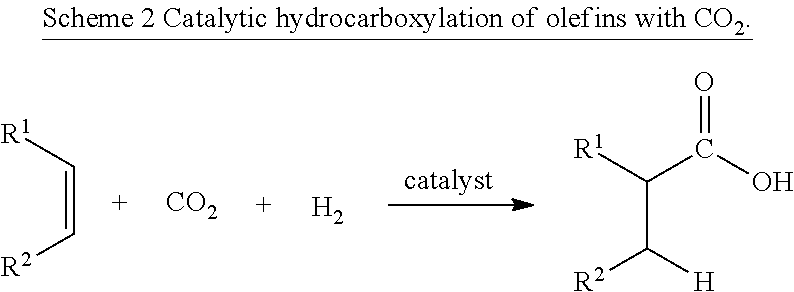Method of producing higher alkanones, preferably 6-undecanone, and derivatives thereof
a technology of alkanone and alkanone, which is applied in the direction of carboxylic compound separation/purification, carbon monoxide reaction carboxylic preparation, organic compound preparation, etc., can solve the problems of increasing the cost of producing ketones, animal fats as raw materials still meet little client acceptance, and destruction of rainfores
- Summary
- Abstract
- Description
- Claims
- Application Information
AI Technical Summary
Benefits of technology
Problems solved by technology
Method used
Image
Examples
example 1
[0082]Clostridium kluyven Forming Hexanoic Acid from Acetate and Ethanol
[0083]For the biotransformation of ethanol and acetate to hexanoic acid the bacterium Clostridium kluyveri was used. All cultivation steps were carried out under anaerobic conditions in pressure-resistant glass bottles that can be closed airtight with a butyl rubber stopper.
[0084]For the preculture 100 ml of DMSZ52 medium (pH=7.0; 10 g / L K-acetate, 0.31 g / L K2HPO4, 0.23 g / L KH2PO4, 0.25 g / l NH4Cl, 0.20 g / l MgSO4x7 H2O, 1 g / L yeast extract, 0.50 mg / L resazurin, 10 μl / HCl (25%, 7.7 M), 1.5 mg / L FeCl2x4H2O, 70 μg / L ZnCl2x7H2O, 100 μg / L MnCl2x4H2O, 6 μg / L H3BO3, 190 μg / L CoCl2x6H2O, 2 μg / L CuCl2x6H2O, 24 μg / L NiCl2x6H2O, 36 μg / L Na2MO4x2H2O, 0.5 mg / L NaOH, 3 μg / L Na2SeO3x5H2O, 4 μg / L Na2WO4x2H2O, 100 μg / L vitamin B12, 80 μg / L p-aminobenzoic acid, 20 μg / L D(+) Biotin, 200 μg / L nicotinic acid, 100 μg / L D-Ca-pantothenate, 300 μg / L pyridoxine hydrochloride, 200 μg / l thiamine-HClx2H2O, 20 ml / L ethanol, 2.5 g / L NaHCO3, 0....
example 2
[0088]Clostridium kluyven Forming Hexanoic Acid from Butyic Acid and Ethanol
[0089]For the biotransformation of ethanol and butyric acid to hexanoic acid the bacterium Clostridium kluyveri was used. All cultivation steps were carried out under anaerobic conditions in pressure-resistant glass bottles that can be closed airtight with a butyl rubber stopper.
[0090]For the preculture 100 ml of DMSZ52 medium (pH=7.0; 10 g / L K-acetate, 0.31 g / L K2HPO4, 0.23 g / L KH2PO4, 0.25 g / l NH4Cl, 0.20 g / l MgSO4x7 H2O, 1 g / L yeast extract, 0.50 mg / L resazurin, 10 μl / A HCl (25%, 7.7 M), 1.5 mg / L FeCl2x4H2O, 70 μg / L ZnCl2x7H2O, 100 μg / L MnCl2x4H2O, 6 μg / L H3BO3, 190 μg / L CoCl2x6H2O, 2 μg / L CuCl2x6H2O, 24 μg / L NiCl2x6H2O, 36 μg / L Na2MO4x2H2O, 0.5 mg / L NaOH, 3 μg / L Na2SeO3x5H2O, 4 μg / L Na2WO4x2H2O, 100 μg / L vitamin B12, 80 μg / L p-aminobenzoic acid, 20 μg / L D(+) Biotin, 200 μg / L nicotinic acid, 100 μg / L D-Ca-pantothenate, 300 μg / L pyridoxine hydrochloride, 200 μg / l thiamine-HClx2H2O, 20 mVL ethanol, 2.5 g / L ...
example 3
[0095]Cultivation of Clostridium kluyver in Presence of Decane and TOPO
[0096]The bacterium Clostridium kluyver was cultivated for the biotransformation of ethanol and acetate to hexanoic acid. For the inSitu extraction of the produced hexanoic acid a mixture of decane with trioctylphosphineoxide (TOPO) was added to the cultivation. All cultivation steps were carried out under anaerobic conditions in pressure-resistant glass bottles that can be closed airtight with a butyl rubber stopper.
[0097]For the preculture 250 ml of Veri01 medium (pH 7.0; 10 g / L potassium acetate, 0.31 g / L K2HPO4, 0.23 g / L KH2PO4, 0.25 g / L NH4Cl, 0.20 g / L MgSO4X7 H2O, 10 μl / L HCl (7.7 M), 1.5 mg / L FeCl2X4H2O, 36 μg / L ZnCl2, 64 μg / L MnCl2X4H2O, 6 μg / L H3BO3, 190 μg / L CoCl2X6 H2O, 1.2 μg / L CuCl2X6H2O, 24 μg / L NiO2X6H2O, 36 μg / L Na2MO4X2H2O, 0.5 mg / L NaOH, 3 μg / L Na2SeO3X5H2O, 4 μg / L Na2WO4X2H2O, 100 μg / L vitamin B12, 80 μg / L p-aminobenzoic acid, 20 μg / L D(+) Biotin, 200 μg / L nicotinic acid, 100 μg / L D-Ca-pantothe...
PUM
| Property | Measurement | Unit |
|---|---|---|
| Temperature | aaaaa | aaaaa |
| Weight ratio | aaaaa | aaaaa |
Abstract
Description
Claims
Application Information
 Login to View More
Login to View More - R&D
- Intellectual Property
- Life Sciences
- Materials
- Tech Scout
- Unparalleled Data Quality
- Higher Quality Content
- 60% Fewer Hallucinations
Browse by: Latest US Patents, China's latest patents, Technical Efficacy Thesaurus, Application Domain, Technology Topic, Popular Technical Reports.
© 2025 PatSnap. All rights reserved.Legal|Privacy policy|Modern Slavery Act Transparency Statement|Sitemap|About US| Contact US: help@patsnap.com



